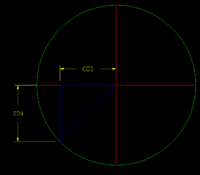You are using an out of date browser. It may not display this or other websites correctly.
You should upgrade or use an alternative browser.
You should upgrade or use an alternative browser.
Find SIN given COS and Radius
- Thread starter markraz
- Start date
pka
Elite Member
- Joined
- Jan 29, 2005
- Messages
- 11,975
Do you mean can one find \(\sin(\theta))\) if we know \(\cos(\theta)=x~\&~ r=\rho~\)?Hi is it possible to find the SIN of circle if I only know the radius and the COS?
Dr.Peterson
Elite Member
- Joined
- Nov 12, 2017
- Messages
- 16,605
You can find the sine of an angle if you only know the cosine; you probably know that identity. I imagine you mean something a little more complicated, but I can't guess what. (A circle doesn't have a sine.)Hi is it possible to find the SIN of circle if I only know the radius and the COS?
markraz
Full Member
- Joined
- Feb 19, 2014
- Messages
- 338
Dr.Peterson
Elite Member
- Joined
- Nov 12, 2017
- Messages
- 16,605
Those are the sine and cosine of the angle in standard position, if it is a unit circle. We never talk about "the sine of a circle" (unless you have been taught something I've never seen).
Maybe you need to tell us how much trigonometry you have learned.
But if what you were asking about is how to find the length you labeled SIN if you know the radius and the length you labeled COS, then a guy named Pythagoras has some good ideas for you ...
Maybe you need to tell us how much trigonometry you have learned.
But if what you were asking about is how to find the length you labeled SIN if you know the radius and the length you labeled COS, then a guy named Pythagoras has some good ideas for you ...
Last edited:
pka
Elite Member
- Joined
- Jan 29, 2005
- Messages
- 11,975
@markraz, you cannot look at a single diagram and then generalize.Thanks. I thought a circle had a sin and a cos like this picture?
First we use polar coordinates to describe circles.
The set \(\{(\rho\cos(t),\rho\sin(t)): 0\le t\le 2\pi\}\) is a circle centered at \((0,0)\) with radius \(\rho\).
In that setup we have \(x=\rho\cos(t)~\&~y=\rho\sin(t)\) Now note that \(x^2+y^2=\rho^2\) which is the classic equation of a circle.
markraz
Full Member
- Joined
- Feb 19, 2014
- Messages
- 338
Thanks for the reply , TBH I have never taken a real math class. I quit Highschool in 9th grade in 1981. I'm trying to teach myself all this stuff now(unless you have been taught something I've never seen).
markraz
Full Member
- Joined
- Feb 19, 2014
- Messages
- 338
Ok thanks, so since if I know X and P can I just plug in the numbers use basic algebra to solve?@markraz, you cannot look at a single diagram and then generalize.
First we use polar coordinates to describe circles.
The set \(\{(\rho\cos(t),\rho\sin(t)): 0\le t\le 2\pi\}\) is a circle centered at \((0,0)\) with radius \(\rho\).
In that setup we have \(x=\rho\cos(t)~\&~y=\rho\sin(t)\) Now note that \(x^2+y^2=\rho^2\) which is the classic equation of a circle.
thanks
D
Deleted member 4993
Guest
You have that wrong. The Pythagorean Trig Identity is:so can I use the pythagorean trig identity? cos^2(x) + sin^2(y) = 1 or
cos^2(x) - 1 = sin^2(y) ??
cos^2(x) + sin^2(x) = 1
or
1 - cos^2(x) = sin^2(x)
Note that here arguments of the sine and cosine functions are same (x).
Dr.Peterson
Elite Member
- Joined
- Nov 12, 2017
- Messages
- 16,605
Or use the Pythagorean Theorem itself, x^2 + y^2 = r^2, which is also the equation of the circle. Here x would be your "COS", and y would be your "SIN". That's if you really want distances, not trig function values.so can I use the pythagorean trig identity? cos^2(x) + sin^2(y) = 1 or
cos^2(x) - 1 = sin^2(y) ??
thanks
I recommend going through at least the first few chapters of a trigonometry textbook (or the trig part of a precalculus textbook), in order to get all these ideas in an orderly way.
markraz
Full Member
- Joined
- Feb 19, 2014
- Messages
- 338
Or use the Pythagorean Theorem itself, x^2 + y^2 = r^2, which is also the equation of the circle. Here x would be your "COS", and y would be your "SIN". That's if you really want distances, not trig function values.
I recommend going through at least the first few chapters of a trigonometry textbook (or the trig part of a precalculus textbook), in order to get all these ideas in an orderly way.
Hi Thanks, this all makes sense now. Appreciate it

